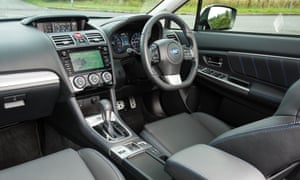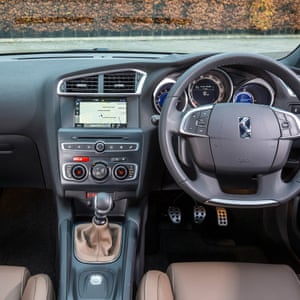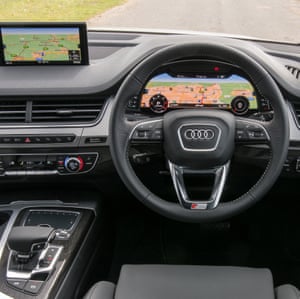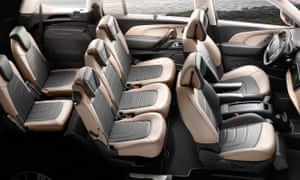Mercedes C63 AMG: <b>car review</b> | Technology | The Guardian |
- Mercedes C63 AMG: <b>car review</b> | Technology | The Guardian
- Subaru Levorg: <b>car review</b> | Martin Love | Technology | The Guardian
- On the road: Citro?n DS <b>car review</b> – 'It has power and poke, even if <b>...</b>
- On the road: Audi Q7 <b>car review</b> – 'Only a hooligan would want to <b>...</b>
- <b>Car Review</b>: 2016 Toyota Prius V | Driving
- Citro?n Grand C4 Picasso: <b>car review</b> | Technology | The Guardian
| Mercedes C63 AMG: <b>car review</b> | Technology | The Guardian Posted: 20 Feb 2016 10:00 PM PST Wolf in sheep's clothing: Mercedes-Benz C63 AMG. Price: £66,810 Last month I went to a quiz night hosted by a motoring firm. It was quite intimidating brushing shoulders with some of the industry's biggest engineering brains. Over pints and pigs in blankets, we swapped tales of torque vectoring and towing capacities. The dress code was very Dad. The questions were of "niche interest" to say the least, but two rounds were hilarious: Guess the Headlamp (various lenses were passed round – one from a 1982 Ford Sierra was identified by a guy on my team) and Make Some Noise – 10 engines were revved over the speakers (it was music to our ears). One of the most distinctive engine notes was made by the Mercedes-Benz C63 AMG. The noise it pumps out of its quadruple sports exhaust is a rich, treacly, rumbling throb. It's magnificent. It is the Richard Burton of exhaust notes. It's a sound that makes you want to turn off the radio and open the window to hear it better. It makes you blip the throttle at the lights just to get passersby to look round. A quick trawl on the internet yields dozens of YouTubes of parked C63s thrashing their engines with captions like: "Brutal Revs", "Pure Sound", "Loudest EVER ROARRRR!!!!"
The strange thing is, however, the C63 looks perfectly average. It isn't some vented and winged hyper car. It's based on the C-Class compact saloon – Benz's bestseller – and it has four doors, a decent boot and five seats. Look closely and you'll see the signs: there's the gigantic air intakes hidden in the front valence; huge callipers cling to each brake disc; a brace of chrome-winged bucket seats glint from behind the smoked glass… And then, of course, there's that engine. The old C63 had a 6.2-litre engine (though why it wasn't called a C62 I don't know). This new model boasts a bi-turbo 4-litre V8. It's smaller, but it produces even more power than before and is more efficient at it, too. It means this Merc is one of the fastest cars you can buy. The AMG-tuned V8 churns out 469bhp and reaches 62mph in 4 seconds – if you can control the wheel spin. I managed to slide the back out in a wet carpark doing less than 10mph. If there was a figure for expletives per mile (EPM?) this would have one of the highest. With each corner you oscillate between terror and near orgasm. You feel all its horse power. At slow speeds the car seems wild-eyed and twitchy: if it had nostrils they'd be snorting. But let it loose and it settles down. Ladle on the power and it gathers its skirts before hammering down the road. It's a total humdinger, a scorching drive. At speed it's rock solid and composed, the aerodynamics gluing it to the tarmac. Inside, it is posh but fairly low key. There's a special AMG instrument cluster and thick three-spoke steering wheel to whiten your knuckles on, but in essence it's still a very usable five-seater. And that's quite clever, because to buy a car like this means you're probably rich. To be rich you're probably middle aged. To be middle aged you probably have a family – and they have to sit somewhere. Boom! Email Martin at martin.love@observer.co.uk or follow him on Twitter @MartinLove166 |
| Subaru Levorg: <b>car review</b> | Martin Love | Technology | The Guardian Posted: 13 Feb 2016 10:00 PM PST Blue streak: as with most Subarus, the Levorg gives few clues as to the performance concealed beneath that enormous hood Price: £27,495 Imagine two drivers standing proudly beside their new cars. One is next to a Mercedes, the other a Subaru. Now picture the same scene a few years down the road. Both have replaced their cars, but which of the two has bought the same brand again? The Benz, surely! In fact it's the Subaru that will be putting in another shift. The marque has phenomenal brand loyalty, higher than Mercedes, BMW and even Porsche. But why such fidelity? Subarus are certainly good cars, but they are not great cars. One answer is that Subaru promotes its range as family oriented, safety minded, outdoorsy, sporty and, above all, dog friendly. (They even joke the 4x4s are "all-paw drive".) A few years ago it ran a whole series of ads featuring a motley crew of dogs using a Subaru to go camping, skiing or for a day at the beach. A drooling collie always drove while his furry mates piled into the back. The ads were funny and featured the tagline: "Dog Tested, Dog Approved". It seems we humans really do buy our cars because dogs rate them. Is that stupid or cute?
Subaru likes to do things its own way. The cars feature patented "boxer" engines, while everyone else favours the more traditional V-Type or inline engines. The unusual set-up creates a wonderfully balanced car for improved handling. It also means the car boasts "symmetrical" four-wheel drive, which few others can. This model is a Levorg, which sounds like a French cyborg. The name, in fact, is a blend of the words "Legacy", "Revolution" and "Touring". The "Legacy" prefix refers to Subaru's retired but much missed performance estate. It was an anonymous-looking beast that wiped the smiles off the lairy faces of hot-hatch owners by blasting them off the road. This new Levorg takes up the mantle and is well up for that sort of fun. Fast, furious, and mundane, the only clue to its amazing thrust is the large air scoop on the bonnet. To drive, it's precise and snappy. Its combination of symmetrical 4x4 and individual suspension means it swallows corners, ruts and the toughest trails with zen-like unflappability. Refreshingly, Subaru doesn't do options. The Levorg comes with just one engine choice (a 1.6-litre turbo), one trim level and one gearbox – an automatic. You can choose the colour: white, grey or blue. It's a godsend for the chronically indecisive. It's also a car that grows on you. Each day I found something new to enjoy, from the onboard tech to the comfortable seats. Maybe in another few weeks I'd be hooked – for life. Canine campers: one of Subaru's many dog and car advertsEmail Martin at martin.love@observer.co.uk or follow him on Twitter @MartinLove166 |
| On the road: Citro?n DS <b>car review</b> – 'It has power and poke, even if <b>...</b> Posted: 12 Feb 2016 10:00 PM PST Citroën DS4. The Citroën DS4 came in Tourmaline Orange. I'm just going to leave that there. I'm definitely not going to point out that tourmaline is a silicate mineral compound and could come in any colour. The DS has a lot of cute, pointless little innovations: the handles on the back doors are at the top of the window, not in the middle of the door; the front grate looks like the alien's smile in Home; there's a whole ton of chrome, which, let's face it, is more of a treat for the onlooker than the driver. I certainly saw no lack of panache in this vehicle, though I struggled to place it between "family" and "fun" (Citroën frames it "for the nonconformist", which is sweet and quite, quite wrong: the last car a nonconformist would buy is a new one). In fact, this ambiguity is deliberate: it's called a Crossback, to mark it out as some advance on a hatchback – a little bit taller, a brawler, roof bars, slightly beefed-up ground clearance. Don't get me wrong; it's no SUV – I'm not sure what kind of ground it's trying to clear. I wouldn't drive it off-road. I think it's just trying to look kooky but grown up, like a woman in a French film who is really into walking on stilts yet still manages to be outrageously sexy. So, when would you drive it? Stop-start keyless ignition, moderately responsive satnav; biddable, six-speed manual engine – city driving is all pretty painless and low maintenance. It doesn't have awesome acceleration, but it does have a top speed higher than it feels (117mph), and greater, too, than you would expect, given its modesty in other areas, such as emissions. It doesn't feel superbly classy inside, however: nothing leaps out at you from the faceless, grey cabin. Nothing in the feel of the materials makes you want to stroke them, or stretch your legs as far as they will go, or shout, "Look at this, kids! Now we're motoring!" in a brittle, hysterical way that makes them worry for you, or twiddle with the dials, or turn up the stereo. Its sober gear changes and sedate steering encourage a kind of resigned maturity in one's driving. Related: On the road: Audi Q7 car review – 'Only a hooligan would want to get mud on it' And yet it certainly has power and poke, even if it understates them. It is a distinctive car, and not just for the colour, but for the shapely headlights and swooshy branding, too. It never makes you want to do an irresponsible thing, nor does it ever make you feel as though you're anything less than safe as houses, on a chic, incredibly thrifty and safe journey to a place that is just so.
Price £23,495 |
| On the road: Audi Q7 <b>car review</b> – 'Only a hooligan would want to <b>...</b> Posted: 29 Jan 2016 10:00 PM PST The whole family missed the Audi Q7 when it was gone: not as a relative or a pet, more like a troubleshooter for your entire existence; Nanny McPhee, except sleek and attractive – wait, that's Mary Poppins. Crikey Moses, it's expensive: at 63 grand, probably about as pricey as a family car could get. It is, for me, a borderline fictional car, one I could imagine buying only if all other cars were sold out. But in that fictional universe, I would have a blast. It has quite an understated look, exec-y silver exterior, grey leather interior, the kind of car you might buy if you had a drug-dealing empire and wanted to splash some cash without getting stopped by the police the whole time. Headlamps and interior controls have the same slender, grown-up styling. It's never lumbering or clumsy, it has shaved a lot of weight off its previous incarnation, and yet it is massive: the option of seven seats, or a boot big enough to live in. The parking camera is the most accurate I've encountered, the satnav responds like it's on University Challenge. Indeed, the entire driving experience is a little heightened and idealised, like living in an advert: the four-wheel drive traction is muscular and sure, the handling makes you feel like a pro, the ride is incredibly smooth over almost everything. The temptation to go too fast – you can get to 62mph from nothing in 6.5 seconds – down medieval city streets is ever-present, which is ironic when you are the person who stands on the road shaking her fist at people who go at 24mph, like Popeye. The gentle quiet of any journey, at any speed, is like a lullaby. The automatic eight-speed gearbox is more intelligent than I will ever be. Related: Renault Kadjar: 'A very French sort of SUV' – car review Yet in the real world, there are real-world downsides: the optional 21-inch wheels send the emissions up to 163g/km, which isn't grotesque in this 4x4 class and you wouldn't blink at it from a Range Rover, but nor is it necessary. Its charm is its plushness and only a hooligan would want to get mud on it. But that being the case, the towing capability is unnecessary, and fiddly details such as brushed aluminium inlays can land a grand on the price; maybe, when money is no object, that poses no objection, but I found it unseemly. Yet returning to the world of make-believe, where you can jump into pavements and dance with penguins, it's just lovely.
Price £63,025 |
| <b>Car Review</b>: 2016 Toyota Prius V | Driving Posted: 23 Feb 2016 03:00 AM PST Overview2016 Toyota Prius A versatile wagon with hybrid benefits Pros Versatility, ride comfort, fuel economy Cons SofTex faux leather, no blind spot monitoring Value for money Good What would I change? Offer a real leather option and add blind spot monitoring as standard equipment The Toyota Prius was the first viable hybrid to hit Canadian roads back in 2000. Since then, the range has blossomed to include a number of different models including the Prius V. This model takes the hybrid basics and adds a healthy dose of versatility. The key to the transformation from regular hatchback to station wagon is found in the roofline. Rather than plunging downward towards the rear bumper the instant it hits the back seat, it's taller and runs horizontally all the way to the near-vertical liftgate. This opens up a ton of interior space. With the 60/40 split/folding rear seats upright, the Prius V makes light work of 971 litres of cargo. Dropping the seats reveals a flat floor and a generous 1,906 litres of capacity. Then there are the neat touches. Beyond the extra space, the Prius V's rear seats slide back and forth. This maximizes legroom – and there is a ton of it – or increases the seats-up cargo capacity by 167 litres when in the forward position. There is also underfloor storage, the cargo net, tie-downs and a proper place to store the privacy cover when it is not in use. The latter means it will not be left gathering dust in the garage on the very day it's needed. The rest of the cabin's layout is very familiar — the instrumentation sits atop the centre stack rather than behind the steering wheel. The format is entirely logical, if unconventional, placing all of the required information and controls within easy reach. Adding the Technology package then brings a wealth of extra equipment, although it did add a significant $5,985 to the base price. Along with active cruise control, Toyota's pre-collision system and lane departure warning comes everything from larger 17-inch wheels and LED headlights with automatic high beams, to an eight-way power driver's seat with four-way lumbar adjustment, and a 6.1-inch touchscreen that looks after the infotainment, phone and navigation functions. It also gives a detailed view of how the hybrid system is functioning. What's missing from the lengthy list of equipment is blind spot monitoring. The cabin's lone letdown were some of the materials. They really weren't in keeping with the rest of the car. The plastics that ring the cabin were hard, but otherwise fine; it was the SofTex "leather" that disappointed. It was pretty obvious no bovine life was sacrificed to upholster the seats, steering wheel and lid of the central storage bin. The fixed two-panel panoramic moonroof, which is part of the Tech package, is interesting as it is made from a lightweight polycarbonate material that's 40 per cent lighter than a glass panel. Aside from the obvious mass reduction, it serves to impart an airy feel to the cabin and lower centre of gravity, which helps handling. Here, the Prius V remains very crossover-like in that the ride is favoured over outright handling. In this case, that's not such a bad thing. With five aboard – and it does accommodate five riders very nicely – the Prius V wafts over gnarly sections of pavement without the unseemly jostling found in many crossovers. Heading into a corner, the Prius V did begin to roll, but it held the driver's line commendably well, even when loaded. Likewise, the electrically assisted steering had some real feel, and the grip afforded by the upsized 17-inch wheel and tire package reined in understeer. In the end, the Prius V mirrors the class norm — it is not a sports wagon. Toyota's Hybrid Synergy Drive powers the Prius V. Along with the nickel-metal hydrid battery and electric motor comes a 1.8-litre four-cylinder gas engine that operates on the Atkinson cycle. This cycle is more efficient, but delivers less output — 98 horsepower and 105 lb.-ft. of torque. The electric motor masks the lower numbers and with the two power sources working together, the Prius V has a net system output of 136 horsepower. As with Toyota's other hybrids, the power is relayed to the front wheels through an electronically controlled continuously variable transmission. It features four drive modes — electric only EV, Eco, Normal and Power. The Eco mode tended to blunt the performance in the name of fuel economy; the Power mode did improve performance, but it held the engine at higher revs for longer periods of time (read: noisy). This saw the bulk of the test conducted in Normal, as it delivered the best balance between economy and performance. On that note, the Prius V ran from zero to 100 km/h in 11.4 seconds while returning a test average of 5.7 L/100 km. The performance did not wow, although it was more than enough for everyday driving; the economy, given the space and flexibility at play, most certainly did. The Toyota Prius V represents a viable alternative to the traditional crossover — it blends the fuel economy benefits of a hybrid miser with the practicality and flexibility of a station wagon or compact crossover nicely.
|
| Citro?n Grand C4 Picasso: <b>car review</b> | Technology | The Guardian Posted: 30 Jan 2016 10:00 PM PST Price: £19,970 I mentioned the new Picasso to my wife over breakfast a few weeks ago and she thought I was talking about the painter rather than Citroën's latest MPV. That was her first reference point. Awkward! For a few moments we peered at each other across the table, and across the unfathomable cultural void, before she sighed and turned back to her paper. I don't know why a French company would name its all-conquering people carrier after a Spanish painter, but Pablo is the godfather of cubism and the Picasso is the godfather of boxy cars. The Citroën also does what few other MPVs even get close to: it manages to be stylish yet spacious, and practical yet posh. That's a winning combo. Before you hop in, take a moment to admire it and its eye-catching blend of flowing lines and curves. The double chevron of the grille spreads neatly into those sleek running lights, while two rails swirl up and over the roof before curling into a pair of large Cs around the back. Nice, isn't it?
Right, in we get. The first thing that hits you is the amazing space available and the incredible amount of glass. Light streams through the panoramic roof which runs the whole length of the car. Coupled with the deep windows, on a hot day you'd soon start to feel like a tomato plant in a poorly ventilated greenhouse. The windscreen itself is one of the biggest fitted to any car on the road. The next size up is for lorries and buses. I sit inside and marvel at its scale. I then realise you can push back the sunblinds so they reach right over your head and join the panoramic roof. It feels more like sitting in a bubble than a car. It comes as both a five- and seven-seater, but Citroën believes it will sell twice as many of the latter. This is, above everything, a car built for growing families. Up front the huge dash boasts both a 12in info screen and a smaller 7in one beneath it, for all your social connectivity "needs", apparently. But do you really need Tinder on the M4? In the back, the second and third rows have an easy one-touch folding mechanism which means you could pull over and create a dormitory in seconds. The top spec also comes with double glazing to hush all road noise. Inside, volume control is down to you. At the wheel it's comfortable rather than racy. It wallows in the bends, but what did you expect? If you have five kids in the back you should have other things on your mind anyway. Safe, comforting, reliable… You'll love this car, but I suspect Picasso would have hated it. Email Martin at martin.love@observer.co.uk or follow him on Twitter at @MartinLove166 |
| You are subscribed to email updates from car review - Google Blog Search. To stop receiving these emails, you may unsubscribe now. | Email delivery powered by Google |
| Google Inc., 1600 Amphitheatre Parkway, Mountain View, CA 94043, United States | |






No comments:
Post a Comment